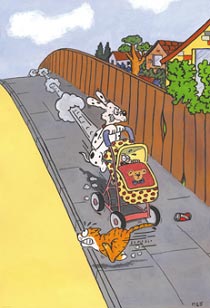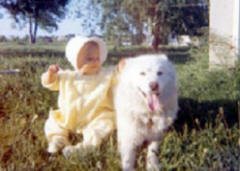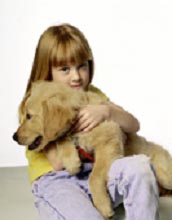The
birth of a baby or adoption
of a new child is associated
with a great deal of anxiety,
excitement, and stress for not
only the family, but also the
family pet. Some dogs and cats
can have a difficult time adjusting
to these changes, especially
if this is your first child,
but preparation and planning
will help.
How
is my pet likely to respond
to the new arrival?
There
are so many different variables
that it is impossible to accurately
predict the way that any pet
might get along with children.
However, there are considerations
that give some insight into
how your pet might react.
 How
much exposure has your pet had
previously to children? How
has your pet reacted when it
has been exposed? The most serious
concern is the pet that has
previously reacted aggressively
or fearfully with children.
If there have been previous
problems you should consult
with a veterinary behaviorist
to determine the situations
that have previously led to
aggression, and the safest way,
if any, to make the transition.
If the pet's previous
problems were with a specific
child, a specific age group
or under specific circumstances,
it may be possible to design
a program so that the previous
situations that resulted in
aggression can be treated and
resolved prior to the arrival
of your new child. How
much exposure has your pet had
previously to children? How
has your pet reacted when it
has been exposed? The most serious
concern is the pet that has
previously reacted aggressively
or fearfully with children.
If there have been previous
problems you should consult
with a veterinary behaviorist
to determine the situations
that have previously led to
aggression, and the safest way,
if any, to make the transition.
If the pet's previous
problems were with a specific
child, a specific age group
or under specific circumstances,
it may be possible to design
a program so that the previous
situations that resulted in
aggression can be treated and
resolved prior to the arrival
of your new child.
The
next most serious concern is
the pet that has had little
or no exposure to young children
or babies. A lack of early socialization
to children may lead to some
initial anxiety or fear associated
with the sights, sounds and
odors of the new child. If there
are no unpleasant experiences
when the child first arrives,
and the first few introductions
are made positive, there may
be no problems. Even if a pet
has shown no previous problems
when interacting with children,
keeping all introductions positive
will help to get the relationship
between your pet and your new
child off to a good start.
One
final concern is the growth
and development of your child.
As your child progresses from
being carried to one that rolls,
crawls, and begins to walk,
and so on through childhood,
some pets may have trouble adapting
to one or more of these changes.
Fear, dominance challenges,
possessive displays, and playful
behaviors could result in aggression.
Anxiety or fear could lead to
anorexia, compulsive disorders
(e.g. flank sucking, acral lick
dermatitis), or destructiveness
(e.g. house-soiling, marking,
chewing, digging).
What
can we do to prepare for the
new arrival?
Behavior
problems (destructiveness, house-soiling,
compulsive disorders, increased
demands for attention, generalized
anxiety) may not develop directly
from the arrival of the child,
but rather from the changes
in the household, associated
with the new arrival. With nine
months or more to prepare for
a baby's arrival, the
best way to minimize problems
and help the pet to cope is
to make changes gradually so
that they have been completed
prior to the arrival of the
child. Consider any changes
that you may need to make in
the pet's schedule, housing,
play, exercise, or attention,
so that adjustments can begin
to be made well before the baby's
arrival. Set up the nursery
in advance and if the pet is
to be kept out of the room,
access should be denied before
the child's arrival. Otherwise,
if your intention is to allow
your pet to continue to enter
the room when supervised, begin
to accompany your pet into the
nursery, so that it can adapt
to the new odors and new setup.
The dog should be allowed to
investigate the baby's
room, blankets, and new furniture,
and praised or given a small
food treat so that it can develop
a positive association with
each of these new cues. 
For
dogs, reviewing or upgrading
obedience skills is essential
so that you can safely and effectively
control your dog in all situations.
Obedience training should be
reviewed every day, in a variety
of locations and circumstances.
Practice each command in different
rooms of the home, in the yard,
while out on walks, and when
visitors come to the home. Concentrate
on those commands that are presently
the least successful, using
prompts and rewards to achieve
success and then gradually shaping
the response so that the pet
stays for progressively longer
times, comes from greater distances
and will heel and follow even
when there are distractions.
Any existing behavior problems
should be resolved before the
arrival of your baby.
Some
pets might become anxious of,
or fearful toward, any of the
new and different stimuli associated
with the sights, sounds, or
odors of the new child. New
activities associated with childcare
can be practiced in front of
pets so that they can become
familiar with them. Tape recordings
or videos of babies crying,
holding a doll wrapped in a
blanket, taking your dog for
a walk beside a stroller or
baby carriage, or even going
through the motions of changing
a diaper and applying baby powder
will simulate some of the experiences
to which your pet will soon
be exposed. If there is any
sign of anxiety associated with
any of these situations, then
more formal reward-based training
should be practiced and repeated
until the pet exhibits no problems
in the presence of the stimuli.
By providing a favored chew
toy, giving a food reward, or
providing extra affection during
these activities, your pet may
actually learn to enjoy these
new stimuli.
Once
your pet shows no fear or anxiety
in some or all of these situations,
you may want to enlist the help
of some friends or relatives
with young children. Dogs can
be taken for a walk while the
child is rolled in the stroller
or carriage. A baby can be carried
around the home or nursed in
the presence of the dog and
children should be encouraged
to play at  the
opposite end of a room or yard
from where the dog is situated.
The dog must be well controlled,
preferably with a leash and
head halter, and given food
rewards and/or play to keep
the association positive. A
wire-meshed muzzle could also
be applied to ensure additional
safety, especially when being
exposed to new situations. By
the end of the visit it may
even be possible to let the
dog interact with the child
but only if it remains friendly
and shows no fear or anxiety. the
opposite end of a room or yard
from where the dog is situated.
The dog must be well controlled,
preferably with a leash and
head halter, and given food
rewards and/or play to keep
the association positive. A
wire-meshed muzzle could also
be applied to ensure additional
safety, especially when being
exposed to new situations. By
the end of the visit it may
even be possible to let the
dog interact with the child
but only if it remains friendly
and shows no fear or anxiety.
For
cats, the most important adaptation
is to any changes that will
be needed in the cat's
home. Although fear and anxiety
to the sights and sounds of
a new baby are possible, adapting
to changes in the household
are often the most trying for
cats. For example, obtaining
new furniture, altering the
cat's feeding, sleeping,
elimination or play areas, and
trying to keep the cat out of
certain locations such as the
crib, should all be considered
before the arrival of the baby.
To reduce the chances of the
cat marking new furniture, the
first few introductions to the
new areas should be well supervised.
Once your cat has investigated
and rubbed against the new furniture,
spraying is far less likely.
Similarly, when the crib or
cradle is first set up, the
cat may wish to mark the area,
or investigate, or even to sleep
in the crib. Booby trapping
areas (see our handout Controlling
undesirable behavior in cats
– the role of punishment)
can teach the cat to stay away
from the areas of concern, well
before the baby arrives.
Remember,
each of these techniques are
intended to help the pet adapt
to changes in the household
or lifestyle before the arrival
of the baby. Once the baby arrives,
there will be far less time
to deal with the needs of the
pet, and there will be additional
variables to which your pet
will need to adapt. Even if
your pet does begin to exhibit
fear or anxiety, during this
pre-arrival training, such anxiety
will not be associated with
the presence of the child. The
cat will have no reason to develop
animosity to the new child.
What should be done
when the baby arrives?
Progress
gradually, avoid any situations
that might lead to fear, anxiety
or discomfort in the baby's
presence and make all associations
and experiences in the baby's
presence positive. Maintain
or even increase the amount
and type of training, exercise,
and play.
Even
a curious and affectionate pet
may have some problems adjusting
to the new arrival. Jumping
up to greet when the baby is
being carried, barking during
the baby's sleep or nap
times, raiding the diaper pail,
licking the baby's face,
or cuddling up to sleep against
an infant who is still unable
to shift position are just a
few of the concerns and potential
problems that pet owners may
need to deal with. Keep your
pet's nails well trimmed.
Supervise all interactions between
the pet and baby. Keep the pet
out of the baby's room
during nap and sleeping times.
Ensure that your dog is well
controlled and responsive to
obedience training commands.
For some dogs, leaving a leash
attached (preferably to a head
collar) is a useful way to ensure
additional control.
The
most important aspect of retraining
is to reward the pet for obedient
and relaxed behavior in the
presence of the child. In many
households there will be less
time and energy available for
the pet. While focused on the
child, or attending to the chores
associated with parenthood,
the pet may be ignored, disciplined
for approaching too close, or
confined to a different area
of the home. Your pet may still
receive its play, exercise,
affection, food and attention,
but often not until the baby
is finally asleep or is under
the care of some other family
member. Many pets soon learn
that the presence of the baby
is a time for inattention, confinement,
or even punishment, while the
absence of the baby is a cue
for "good things"
to happen. This must be reversed.
Every effort should be made
to allow the pet into the room
for food, play or affection
when the baby is present. Feed
the pet when the baby is being
fed, or have another family
member give affection to the
pet, play with the pet, or do
some reward training (stay,
go to your mat) when the child
is in the room. Take your dog
outdoors for play or a walk
when you are taking the child
out. The goal is to teach the
pet that positives or "good
things" are most likely
to happen in the presence of
the child and to avoid any negative
association with the child.
What
should be done if aggression
arises?
Such
behavior is very upsetting,
regardless of its reasons. An
immediate decision on whether
to keep and work with the pet
or remove it from the home must
be made. Dogs targeting children
may be motivated by fear, dominance,
possessive, redirected, playful
or predatory aggression. Such
aggression (particularly predatory
and fear) may arise immediately
when the child is brought into
the home, or may begin as the
child becomes more mobile (e.g.
fear, predation, possessive,
play) or when the child grows
a little older and begins to
challenge the dog (fear, dominance,
possessive, play). Cat aggression
toward children can be fear-induced,
redirected, territorial, or
play/predatory. For most aggression
cases, especially those directed
toward children, the guidance
and advice of a behaviorist
is strongly suggested since
it will be necessary to make
an accurate diagnosis, determine
the prognosis (the chances of
safe and effective treatment)
and guide you through a treatment
program. Although some cases
may be treated quickly and safely,
most cases require extensive
precautions to prevent injuries
and a great deal of time, effort
and commitment. Regardless of
reason for aggression, biting
dogs should be leashed (attached
to the owner) preferably with
a head collar, muzzled and closely
supervised or kenneled in the
presence of small children.
Aggressive cats should be confined
away from small children except
when they are in a carrier,
on a leash and harness, or well
supervised and either calm or
otherwise occupied with food
or toys. For a discussion of
specific types of aggression
ask for our other handouts.
How
can I teach my children to be
safe around pets?
Although
there are no rules that will
guarantee safety, there are
important guidelines that can
be followed to reduce the chances
of problems and the risk of
injury. The first rule of thumb
is to avoid doing anything to
the dog that you might not want
your child to do. This would
include physical punishment,
rough play, or teasing. Children
must be taught how to interact
with and handle their family
pet including how to approach,
pat or lift small pets. Wherever
possible, play sessions and
training should include the
children with the supervision
of a parent. This can begin
from the time the dog is a puppy
by attending puppy classes and
obedience classes that include
all members of the family. If
the pet has not previously exhibited
possessiveness of food or toys,
the adults can practice with
the children approaching the
dog at its food bowl, patting
and giving favored treats, along
with teaching the give or drop
command for favored treats.
It may be best to use a leash
and head halter during this
training if there is any concern
that the dog might resist or
become anxious. 
While
your dog may appear to tolerate
or even enjoy handling from
people of all ages, you must
teach your child how to meet,
greet and handle animals. The
child will be safest if taught
to avoid hugging, tugging on
the leash, collar or tail and
handling around the eyes, ears
and muzzle. Even if the dog
is familiar it is best to avoid
reaching toward the head or
face to face greetings.
Children
must also be taught that strange
pets may not behave in the same
way as their family pet. A simple
rule is that the child should
NEVER approach another family's
pet without being given permission
and then to approach slowly
and avoid reaching for the head
and face. Children should be
taught to avoid pets entirely
if they are displaying any signs
that might indicate fearfulness
(shaking, ears back, tail between
legs, crouch, trying to escape)
or aggression (growling, showing
teeth, barking, hair standing
on end). Although most children
would be tempted to run away
from an aggressive dog, they
should be taught to stand still
like a tree, with the arms against
the body, and avoid eye contact
and yelling or screaming. If
the child is on the ground they
should curl up and cover their
head and ears with their arms
and fists, and remain still
until the dog moves away. Any
threatening dog or bite should
be immediately reported to an
adult.
|